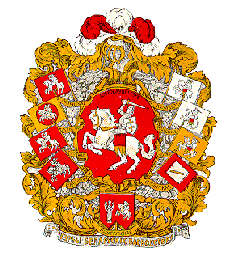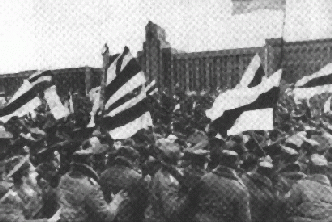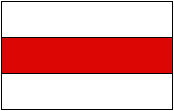Minsk History:
Towards Independence
The coats-of-arms of Belarusian counties
 Later
came the First World War and one of the most dramatic episodes in the city's history --
the power-struggle between the Belarusian National Rada and the Bolsheviks from 1917-1919.
On the national side stood such distinguished patriots as Professor E. Karski, General K.
Aliexejeuski, Anton Luckievicz, Edvard Vajnilovicz, the poet Ales Harun, Col. Kastus
Jezavitau, Janka Kupala, Jazep Varonka, Count Skirmunt, Zmitrok Biadulia, Princess
Mahdaliena Radzivil(the Countess Markievicz of Belarus) and others, in particular the
railway workers. The Bolshevik side was led by Russian internationalist and professional
revolutionaries -- Lander, Knorin, and Miasnikou, -- backed by mutinous but well armed
Tsarist soldiers, who ultimately prevailed. Over the next twenty years, however, the bold
ideas of the socialist revolution became stained with the blood of hundreds of thousands
of victims summarily shot by Bolshevik special units in the "killing-fields" of
Golden Hill and Kurapaty. Many more starved to death as a result of collectivization of
agricultural land, hastily introduced by the 9th All-Belarusian Soviet Congress held in
Minsk(1929).
Later
came the First World War and one of the most dramatic episodes in the city's history --
the power-struggle between the Belarusian National Rada and the Bolsheviks from 1917-1919.
On the national side stood such distinguished patriots as Professor E. Karski, General K.
Aliexejeuski, Anton Luckievicz, Edvard Vajnilovicz, the poet Ales Harun, Col. Kastus
Jezavitau, Janka Kupala, Jazep Varonka, Count Skirmunt, Zmitrok Biadulia, Princess
Mahdaliena Radzivil(the Countess Markievicz of Belarus) and others, in particular the
railway workers. The Bolshevik side was led by Russian internationalist and professional
revolutionaries -- Lander, Knorin, and Miasnikou, -- backed by mutinous but well armed
Tsarist soldiers, who ultimately prevailed. Over the next twenty years, however, the bold
ideas of the socialist revolution became stained with the blood of hundreds of thousands
of victims summarily shot by Bolshevik special units in the "killing-fields" of
Golden Hill and Kurapaty. Many more starved to death as a result of collectivization of
agricultural land, hastily introduced by the 9th All-Belarusian Soviet Congress held in
Minsk(1929).
Minsk after the World War II
 The arrival of the Germans in 1941, after
the encirclement near Minsk by General von Bock of 300,000 Red Army soldiers with more
than 300 tanks, brought more bloodshed with the Nazi mass murders. However, many Jews
escaping death at the hands of the Nazis were sheltered and helped by the local populace.
There followed more executions and mass-deportations by the Bolsheviks of the so-called
"collaborators". Yet some good came from all these ills: Eastern and Western
Belarus(formerly under Poland) were reunited in 1939. The Belarusian Republic was admitted
as a founding member of the United Nations in 1946. The ruined city of Minsk was rebuilt
as the show-place capital of the modern Republic, larger and more populous than Bulgaria,
Denmark, Portugal or Hungary.
The arrival of the Germans in 1941, after
the encirclement near Minsk by General von Bock of 300,000 Red Army soldiers with more
than 300 tanks, brought more bloodshed with the Nazi mass murders. However, many Jews
escaping death at the hands of the Nazis were sheltered and helped by the local populace.
There followed more executions and mass-deportations by the Bolsheviks of the so-called
"collaborators". Yet some good came from all these ills: Eastern and Western
Belarus(formerly under Poland) were reunited in 1939. The Belarusian Republic was admitted
as a founding member of the United Nations in 1946. The ruined city of Minsk was rebuilt
as the show-place capital of the modern Republic, larger and more populous than Bulgaria,
Denmark, Portugal or Hungary.
The awakening to nationhood in 1863 and 1904, the role played by the citizens of Minsk
of every class in the creation of an independent Republic in 1918, and the subsequent
destiny of the city as the cultural capital of Belarus, rather than of some administrative
area in a Marxist dreamworld, -- all these cemented by years of strife, suffering and
persecution during the Revolution and the Nazi-Soviet conflict(1941 - 1945), has helped to
make Minsk a united city with a character very much of its own. Despite the destruction
and thoughtlessness of planners, a great deal of the old Minsk has survived, and is being
painstakingly restored. Neither were the visions of the totalitarian idealists entirely
fruitless, as the fine avenues, squares, parks and impressive new buildings of the new
Minsk demonstrate. These were result of plans drawn as long ago as 1926, which included
constructivist art deco of Government House(1934), the National Opera and
Ballet(1939) and the Academy of Sciences(c. 1935) by Ja. Langbard, and later in 1944 with
the impressive neo-classicism of the Congress Palace (1954), the Polytechnical
Intitute(1946), Victory Square(1954) and Skaryna Avenue. Industry, technology and the arts
have made great strides, and city now boats two airports and a fine modern underground
railway system. It has become an international city on the circuits of world statesmen.
A public demonstration in Minsk in 1989
 But perhaps the greatest moments of Minsk have
been in the recent past, when mass rallies in Independence Square, at the Kupala monument,
in the City Sports Stadium, and at Kurapaty, showed to the world that the "forgotten
people" has at last become a nation, with the crowds taking up the historic cry of
the old peasants at the All-Belarusian congress in 1917, as the elderly General
Alexiejeuski, -- a boy at the time of Kalinouskki' uprising(1863), -- kissed the
white-red-white flag: "Long live free Belarus! Long live the national flag!".
But perhaps the greatest moments of Minsk have
been in the recent past, when mass rallies in Independence Square, at the Kupala monument,
in the City Sports Stadium, and at Kurapaty, showed to the world that the "forgotten
people" has at last become a nation, with the crowds taking up the historic cry of
the old peasants at the All-Belarusian congress in 1917, as the elderly General
Alexiejeuski, -- a boy at the time of Kalinouskki' uprising(1863), -- kissed the
white-red-white flag: "Long live free Belarus! Long live the national flag!".
Both old and new Minsk have their history and their achievements, which are there for
citizen and visitor to enjoy. What has, like Dublin, become known as the Kachany Horad
("The dear old Town") on a Golden Hill, a city of icons resplendent with gold,
in which filigree gates of gold are created out of something as commonplace, yet as rich
as plaited straw, where all the children seem to have golden hair, is surely a fitting
capital for the land which poets have called "Belarus, golden Belarus".

![[Previous]](../../images/misc/previous.gif)
![[Up]](../../images/misc/up.gif)
 Later
came the First World War and one of the most dramatic episodes in the city's history --
the power-struggle between the Belarusian National Rada and the Bolsheviks from 1917-1919.
On the national side stood such distinguished patriots as Professor E. Karski, General K.
Aliexejeuski, Anton Luckievicz, Edvard Vajnilovicz, the poet Ales Harun, Col. Kastus
Jezavitau, Janka Kupala, Jazep Varonka, Count Skirmunt, Zmitrok Biadulia, Princess
Mahdaliena Radzivil(the Countess Markievicz of Belarus) and others, in particular the
railway workers. The Bolshevik side was led by Russian internationalist and professional
revolutionaries -- Lander, Knorin, and Miasnikou, -- backed by mutinous but well armed
Tsarist soldiers, who ultimately prevailed. Over the next twenty years, however, the bold
ideas of the socialist revolution became stained with the blood of hundreds of thousands
of victims summarily shot by Bolshevik special units in the "killing-fields" of
Golden Hill and Kurapaty. Many more starved to death as a result of collectivization of
agricultural land, hastily introduced by the 9th All-Belarusian Soviet Congress held in
Minsk(1929).
Later
came the First World War and one of the most dramatic episodes in the city's history --
the power-struggle between the Belarusian National Rada and the Bolsheviks from 1917-1919.
On the national side stood such distinguished patriots as Professor E. Karski, General K.
Aliexejeuski, Anton Luckievicz, Edvard Vajnilovicz, the poet Ales Harun, Col. Kastus
Jezavitau, Janka Kupala, Jazep Varonka, Count Skirmunt, Zmitrok Biadulia, Princess
Mahdaliena Radzivil(the Countess Markievicz of Belarus) and others, in particular the
railway workers. The Bolshevik side was led by Russian internationalist and professional
revolutionaries -- Lander, Knorin, and Miasnikou, -- backed by mutinous but well armed
Tsarist soldiers, who ultimately prevailed. Over the next twenty years, however, the bold
ideas of the socialist revolution became stained with the blood of hundreds of thousands
of victims summarily shot by Bolshevik special units in the "killing-fields" of
Golden Hill and Kurapaty. Many more starved to death as a result of collectivization of
agricultural land, hastily introduced by the 9th All-Belarusian Soviet Congress held in
Minsk(1929). 

